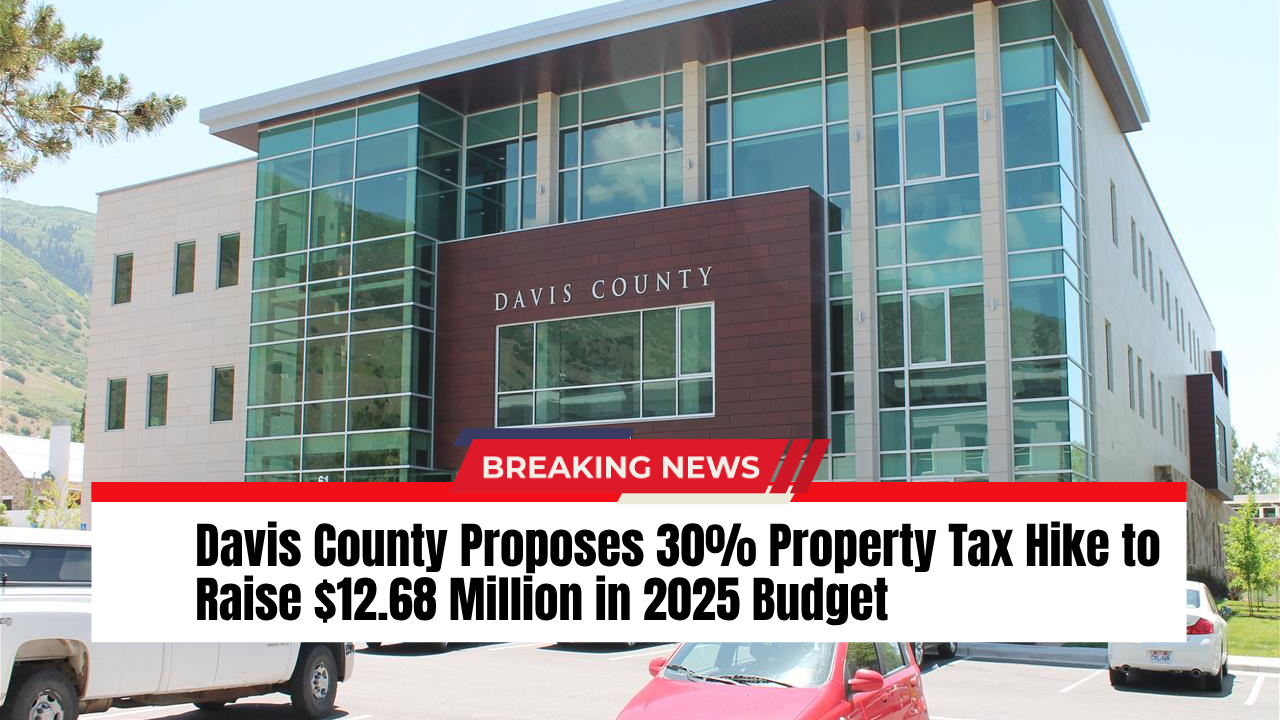Facing growing costs in public safety, infrastructure, and employee wages, Davis County leaders have proposed a property tax increase of up to 30% to help balance the 2025 fiscal budget. The plan would raise an estimated $12.68 million in new revenue, marking the county’s first significant tax adjustment in nearly a decade.
The proposal, unveiled during a public budget presentation, has drawn both support and concern from residents and officials. County leaders argue that the increase is essential to maintain core services amid inflation and population growth, while critics worry about the impact on households already strained by rising housing costs.
Why Davis County Leaders Say a Tax Hike Is Needed
The proposed increase is part of a broader budget strategy designed to close funding gaps in law enforcement, court operations, and infrastructure maintenance.
According to the Davis County Commission, more than 60% of the county’s general fund is devoted to public safety services, including the sheriff’s office, jail operations, and emergency response. Officials say that while demand for these services has steadily increased, revenue growth has lagged behind.
Davis County Commissioner Bob Stevenson said the proposed tax hike is “not ideal but necessary” to sustain operations. “Costs have risen dramatically — from utilities and insurance to employee wages,” Stevenson explained. “Without additional revenue, we risk cutting critical public safety programs.”
The Davis County Sheriff’s Office and Attorney’s Office have both requested budget increases for 2025, citing recruitment challenges and inflationary pressures.
“Utah’s population growth and inflation are hitting county budgets hard,” Stevenson added. “This proposal ensures we can continue providing essential services without compromising public safety.”
| Category | 2024 Funding | 2025 Proposed Increase | New Total |
|---|---|---|---|
| Public Safety | $41.2M | +$6.8M | $48M |
| Judicial & Legal Services | $12.1M | +$2.3M | $14.4M |
| Infrastructure & Facilities | $8.5M | +$1.2M | $9.7M |
| Total New Revenue | – | $12.68M | $12.68M |
The Davis County Finance Department noted that rising costs for inmate healthcare, utility bills, and court technology upgrades have all strained the existing budget.
The 30% Increase Explained
If approved, the property tax rate increase would be applied to the county’s general fund, affecting both homeowners and businesses. The average Davis County homeowner, whose property is valued around $520,000, would pay approximately $96 more per year in county taxes.
This adjustment would still leave Davis County’s property tax rate below the state average, according to the Utah State Tax Commission.
Davis County’s growth — now exceeding 370,000 residents, according to U.S. Census Bureau data — has outpaced its revenue base. New developments in cities like Layton, Farmington, and Kaysville continue to drive infrastructure needs and service expansion.
County leaders emphasized that even with the proposed 30% hike, the rate would remain lower than in neighboring counties such as Weber and Salt Lake.
The proposal will undergo a Truth in Taxation hearing later this year, where residents can share feedback before a final vote.
Breakdown of Revenue Allocation
Commissioners outlined several areas where the new revenue would be directed:
- Sheriff’s Office and Jail Staffing: To hire 20 additional deputies and support staff.
- Court and Prosecution Services: Funding for expanded digital filing systems and legal personnel.
- Building Maintenance: Modernization of county facilities, including HVAC and energy upgrades.
- Community Services: Continued funding for senior centers, libraries, and emergency preparedness programs.
Commission Chair Lorene Kamalu said the revenue will also fund mandatory cost-of-living pay adjustments for county employees. “Like everyone else, our workforce is feeling inflation. We have to stay competitive to keep qualified staff,” Kamalu said.
Mixed Reaction From Residents
Reaction to the tax proposal has been mixed among Davis County residents. Some have expressed frustration over the steep increase, while others say they understand the need for sustainable funding.
“I get that costs are rising, but 30% feels extreme,” said Kaysville resident Jim Palmer. “Families are already struggling with mortgage rates and utilities.”
On the other hand, Layton resident Maria Jensen said she supports the plan. “I’d rather pay a little more than see slower emergency response times or cuts to programs that help seniors and families.”
The county plans to mail Truth in Taxation notices to all property owners ahead of the public hearing, scheduled for December 10, 2025, at the Davis County Administration Building in Farmington.
Officials encouraged residents to review details through the county’s budget transparency portal.
Utah’s Broader Tax Landscape
Across Utah, counties and municipalities are grappling with similar fiscal challenges. Several local governments — including Salt Lake County, Weber County, and Utah County — have approved or are considering property tax increases for 2025.
The Utah Department of Transportation (UDOT) and Federal Highway Administration have both highlighted rising costs in infrastructure and maintenance as factors pushing local budgets higher.
Analysts from the Utah Taxpayers Association warn that while tax hikes can stabilize budgets, they may also strain middle-income households in a year already marked by housing affordability issues.
“Utah’s counties are walking a fine line between sustainability and burden,” said association spokesperson Emily Carter. “Transparency and accountability will be key as these proposals move forward.”
The proposed 30% Davis County property tax increase, expected to generate $12.68 million in new revenue, represents a pivotal moment for local governance. Officials say the additional funds are vital for maintaining public safety, judicial services, and infrastructure, while residents weigh the financial impact on their families.
Public hearings in December will determine whether the measure moves forward for adoption in the 2025 fiscal budget. For now, Davis County stands as another example of Utah’s balancing act — funding growth without overburdening taxpayers.



